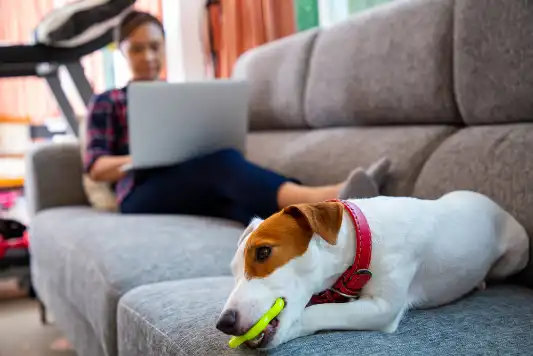pET HEALTH
As dog owners, we know dogs aren’t afraid to chomp down on anything that can fit in their mouth. While it can be entertaining to see a dog walking down the street carrying an entire tree branch or their favorite leaf from the park, the things they find to chew on aren’t always quite so harmless.
For that reason, it’s important to be able to recognize the signs your dog is choking and what to do about it.
How To Tell if a Dog Is Choking
Dogs often explore the world through their nose and mouth, increasing their chances of them chewing on something they probably shouldn’t. It’s important to pay attention to what your pet is putting in their mouth to help avoid choking. Some common choking hazards to watch out for are:
- Their toys, especially small ones
- Bones and rawhides
- Sticks and rocks
- Children’s toys
- Hair ties and rubber bands
- Socks
Much like with humans, one of the first signs that a dog is choking is coughing, retching, and strained breathing.1 However, if their airway is completely blocked, they may not be able to make any sound at all.
Dogs could also paw at their head or mouth and become visibly panicked by pacing, staggering, or even collapsing if they’re choking. In severe cases, your pet could lose consciousness altogether.
If you notice any of these signs in your pet, it’s important to respond as quickly as possible.
How To Help a Choking Dog
If your dog is choking, or even if you suspect they might be, here’s what you should do:
- Try not to panic. When your pet is scared, their instinct might be to lash out or bite. Staying as calm as possible could help keep them calm as well.
- Restrain them. Keeping your dog still can allow you to help them without accidentally causing more damage.
- Look inside their mouth. Gently pry open their jaw and look inside with a flashlight. You may want to sweep your index finger around their mouth to see if you can feel anything that can be easily removed. Be sure to check the roof of the mouth as well, as objects can get stuck there.
- Remove any accessible objects. If you see any objects in your dog’s mouth or throat, you could use a pair of large tweezers or even small tongs to gently pull it out. Pushing the object isn’t recommended, as you could push the stuck object further down into their throat, further complicating the situation.
- Press underneath their jaw. If you see a large object that can’t be removed with tweezers, like a ball or a toy, you could use one thumb on each side of the jaw to press upward and attempt to coax the object out.
If you do not see any objects in your pet’s mouth or throat, but your pet is still in distress, you’ll probably want to get them to the veterinarian as quickly as possible. However, if you do not have time to get to your vet’s office, typically the next step is to employ the heimlich maneuver.
Heimlich Maneuver for Dogs
If you need to perform the Heimlich maneuver on your pet, it’s important to know how to do so properly. Make sure you’re doing it correctly for the size of your dog.
Heimlich maneuver for small dogs
With small dogs, the easiest way to perform the Heimlich maneuver is to lay them on their backs on your lap. Then, using the palm of your hand, press right under their ribcage and push firmly upward up to five times in order to force the object out of their airway. Once you’ve completed the motion, roll them onto their side and check their mouth to see if the object was expelled.
Heimlich maneuver for medium and large dogs
For bigger dogs, there are a couple of ways to go about the Heimlich maneuver.
The first is similar to how you would enact the heimlich on a human — from a standing position. Stand them up on their hind legs and wrap your arms around them from behind and clasp your hands together into a large fist under their ribs. Thrust your fist in a strong upward motion up to five times. This could dislodge whatever is blocking the airway so you’re able to remove it.
The second method should be performed while your dog is laying on the floor. Lay your pup on their side and place one hand on their back, with the other on their abdomen just under their ribcage. While the hand on their back acts as a support, push in and upward with the other hand in order to dispel whatever object is blocking their airway. Then check their mouth for the offending object.
What To Do After Your Dog Chokes
Choking keeps your pet from getting enough oxygen and can damage their mouth and throat, along with potentially other serious repercussions. Once you’ve removed the object blocking their airway, it’s important to get your dog to the vet for an evaluation.
A dog insurance policy from MetLife pet insurance can help cover the costs of any tests and care your pet needs following a choking incident.2 Get a free quote today.

